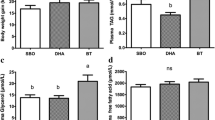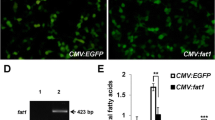Abstract
Omega-3 polyunsaturated fatty acids (n-3 PUFAs) are essential for the development and health of mammals, such as humans and livestock. n-3 PUFAs must be supplied by diet due to the absence of a key gene, namely, delta-15 desaturase (fat1), which is responsible for synthesizing n-3 PUFAs from a major type of n-6 PUFAs, linoleic acid (LA). To increase the dietary intake of n-3 PUFAs for humans, fat1-expressing transgenic (TG) livestock have been produced to provide n-3 PUFA-rich meats for humans. However, these TG livestock synthesized n-3 PUFAs from diet-derived, instead of endogenously produced, n-6 PUFAs because they still lack the delta-12 desaturase (fat2) gene for catalyzing conversion of internal oleic acid (OA) to LA. To fill the gap in the de novo n-3 PUFA biosynthesis pathway and to increase n-3 PUFA content in livestock, TG pigs co-expressing fat1–fat2 were generated in the present work. The OA content decreased in fat1–fat2 TG pigs, suggesting that OA was converted to LA by fat2 transgene-encoded delta-12 desaturase. The n-3 PUFA level was elevated, and the n-6/n-3 PUFA ratio dropped in fat1–fat2 TG pigs, revealing that fat1 transgene promoted the synthesis of n-3 PUFAs from n-6 analogs. The expression levels of fatty acid elongase-5 (ELOVL5) and fatty acid elongase-2 (ELOVL2), which are two key enzyme genes for PUFA synthesis, as well as their transcription factor peroxisome proliferator-activated receptor α, increased in fat1–fat2 TG pigs. Thus, the fat1 transgene enhanced n-3 PUFA synthesis by upregulating the expression of enzyme genes involved in the PUFA synthesis pathways. Overall, this study provided a new strategy to produce n-3 PUFA-rich meat for human consumption. The generated fat1–fat2 TG pigs can also serve as a large animal model for studying the roles of n-3 PUFAs in human development and health.




Similar content being viewed by others
References
Arai R, Ueda H et al (2001) Design of the linkers which effectively separate domains of a bifunctional fusion protein. Protein Eng 14(8):529–532
Arterburn LM, Hall EB et al (2006) Distribution, interconversion, and dose response of n-3 fatty acids in humans. Am J Clin Nutr 83(6 Suppl):1467S–1476S
Chen X, Bai Y et al (2010) Design of an in vivo cleavable disulfide linker in recombinant fusion proteins. Biotechniques 49(1):513
De FP, Luke GA et al (2006) E unum pluribus: multiple proteins from a self-processing polyprotein. Trends Biotechnol 24(2):68–75
Felipe PD, Luke GA et al (2010) Inhibition of 2A-mediated ‘cleavage’ of certain artificial polyproteins bearing N-terminal signal sequences. Biotechnol J 5(2):213–223
François I, Hemelrijck WV (2004) Processing in Arabidopsis thaliana of a heterologous polyprotein resulting in differential targeting of the individual plant defensins. Plant Sci 166(1):113–121
Gustavsson M, Lehtiö J et al (2001) Stable linker peptides for a cellulose-binding domain-lipase fusion protein expressed in Pichia pastoris. Protein Eng 14(9):711–715
Horrocks LA, Yeo YK (1999) Health benefits of docosahexaenoic acid (DHA). Pharmacol Res 40(3):211–225
Jakobsson A, Jörgensen JA et al (2005) Differential regulation of fatty acid elongation enzymes in brown adipocytes implies a unique role for Elovl3 during increased fatty acid oxidation. Am J Physiol Endocrinol Metab 289(4):E517
Kang JX, Wang J, Wu L, Kang ZB (2004) Transgenic mice: fat-1 mice convert n-6 to n-3 fatty acids. Nature 427(6974):504
Kumadaki S, Matsuzaka T et al (2008) Mouse Elovl-6 promoter is an SREBP target. Biochem Biophys Res Commun 368(2):261–266
Lai L, Kang JX et al (2006) Generation of cloned transgenic pigs rich in omega-3 fatty acids. Nat Biotechnol 24(4):435
Minskaia E, Ryan MD (2013) Protein coexpression using FMDV 2A: effect of “linker” residues. Biomed Res Int 2013:291730
Molfino A, Amabile MI, Monti M, Muscaritoli M (2017) Omega-3 polyunsaturated fatty acids in critical illness: anti-inflammatory, proresolving, or both? Oxid Med Cell Longev 2017:5987082
Mori TA (2017) Marine OMEGA-3 fatty acids in the prevention of cardiovascular disease. Fitoterapia 123:51–58
Morimoto KC, Van Eenennaam AL et al (2005) Endogenous production of n-3 and n-6 fatty acids in mammalian cells. J Dairy Sci 88(3):1142–1146
Nakamura MT, Nara TY (2004) Structure, function, and dietary regulation of delta6, delta5, and delta9 desaturases. Annu Rev Nutr 24(6):345–376
Pai VJ, Bin W, Xiangyong L et al (2014) Transgenic mice convert carbohydrates to essential fatty acids. PLoS ONE 9(5):e97637
Pang SC, Wang HP et al (2014) Double transgenesis of humanized fat1 and fat2 genes promotes omega-3 polyunsaturated fatty acids synthesis in a zebrafish model. Mar Biotechnol 16(5):580–593
Peyou-Ndi MM, Watts JL (2000) Identification and characterization of an animal Delta(12) fatty acid desaturase gene by heterologous expression in Saccharomyces cerevisiae. Arch Biochem Biophys 376(2):399–408
Phang M, Skiton MR (2018) Marine omega-3 fatty acids, complications of pregnancy and maternal risk factors for offspring cardio-metabolic disease. Mar Drugs 16(5):pii:E138
Pusceddu MM, Kelly P et al (2016) N-3 polyunsaturated fatty acids through the lifespan: implication for psychopathology. Int J Neuropsychopharmacol 19(12):pyw078
Qin Y, Dalen KT et al (2009) Regulation of hepatic fatty acid elongase 5 by LXRalpha-SREBP-1c. Biochim Biophys Acta 1791(2):140–147
Saeki K, Matsumoto K et al (2004) Functional expression of a Δ12 fatty acid desaturase gene from spinach in transgenic pigs. Proc Natl Acad Sci USA 101(17):6361–6366
Schunck WH, Konkel A et al (2018) Therapeutic potential of omega-3 fatty acid-derived epoxyeicosanoids in cardiovascular and inflammatory diseases. Pharmacol Ther 183:177–204
Shirooie S, Nabavi SF, Dehpour AR, Belwal T, Habtemariam S, Arguelles S, Sureda A, Daglia M, Tomczyk M, Sobarzo-Sanchez E, Xu S, Nabavi SM (2018) Targeting mTORs by omega-3 fatty acids: a possible novel therapeutic strategy for neurodegeneration? Pharmacol Res 135:37–48
Simopoulos AP (1998) Redefining dietary reference values and food safety. World Rev Nutr Diet 83:219–222
Simopoulos AP (2000) Human requirement for n-3 polyunsaturated fatty acids. Poult Sci 79(7):961–970
Simopoulos AP (2001) n-3 fatty acids and human health: defining strategies for public policy. Lipids 36(Suppl(S1)):S83
Wang Y, Botolin D et al (2005) Tissue-specific, nutritional, and developmental regulation of rat fatty acid elongases. J Lipid Res 46(4):706–715
Wang Y, Botolin D et al (2006) Regulation of hepatic fatty acid elongase and desaturase expression in diabetes and obesity. J Lipid Res 47(9):2028–2041
Wang Y, He J et al (2018) Eicosapentaenoic acid improves polycystic ovary syndrome in rats via sterol regulatory element-binding protein 1 (SREBP-1)/toll-like receptor 4 (TLR4) pathway. Med Sci Monit Int Med J Exp Clin Res 24:2091–2097
Wu X, Ouyang H et al (2012) Production of cloned transgenic cow expressing omega-3 fatty acids. Transgenic Res 21(3):537–543
Wu Z, Xu Z et al (2013) Pig transgenesis by piggyBac transposition in combination with somatic cell nuclear transfer. Transgenic Res 22(6):1107–1118
Zárate R, Jaber-Vazdekis NE et al (2017) Significance of long chain polyunsaturated fatty acids in human health. Clin Transl Med 6(1):25
Zhang P, Zhang Y et al (2012) Handmade cloned transgenic piglets expressing the nematode fat-1 gene. Cell Reprogram 14(3):258
Zhang P, Liu P et al (2013) Handmade cloned transgenic sheep rich in omega-3 fatty acids. PLoS ONE 8(2):e55941
Zhou Y, Lin Y et al (2014) The high-level accumulation of n-3 polyunsaturated fatty acids in transgenic pigs harboring the n-3 fatty acid desaturase gene from Caenorhabditis briggsae. Transgenic Res 23(1):89
Zhu G, Chen H et al (2008) A modified n-3 fatty acid desaturase gene from Caenorhabditis briggsae produced high proportion of DHA and DPA in transgenic mice. Transgenic Res 17(4):717–725
Zhu K, Song L et al (2018) The transcriptional factor PPARαb positively regulates Elovl5 Elongase in golden pompano Trachinotus ovatus (Linnaeus 1758). Front Physiol 9:1340
Acknowledgements
This study was supported by a grant from National Science and Technology Major Project of China (Grant No. 2016ZX08006002).
Author information
Authors and Affiliations
Corresponding authors
Ethics declarations
Conflict of interest
All authors declare that they have no conflict of interest that can inappropriately influence or be perceived to influence the present work.
Additional information
Publisher's Note
Springer Nature remains neutral with regard to jurisdictional claims in published maps and institutional affiliations.
Rights and permissions
About this article
Cite this article
Tang, F., Yang, X., Liu, D. et al. Co-expression of fat1 and fat2 in transgenic pigs promotes synthesis of polyunsaturated fatty acids. Transgenic Res 28, 369–379 (2019). https://doi.org/10.1007/s11248-019-00127-4
Received:
Accepted:
Published:
Issue Date:
DOI: https://doi.org/10.1007/s11248-019-00127-4




